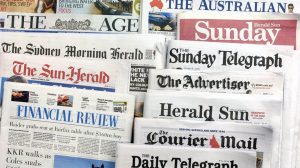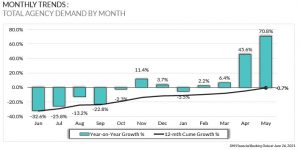
LOCKDOWN ROULETTE – MEDIA WINNERS & LOSERS

Now that we are on another turn of the Covid Carousel, we thought it interesting to see how it may or may not affect the media.
The good news is that we are used to lockdowns and perhaps we’re all less reactive than the first one or two lockdowns. Of course there are still quite a few people that believe stockpiling toilet paper will save them in a crisis. The other issue is this lockdown exactly covers the school holidays. This cruelly affects the Travel Industry once again (& possibly future plans) however school holidays naturally impacts media consumption across certain channels.
So, what does this mean for us right now in the current media market climate?
DIGITAL. Online was a big winner last time and it will likely be a big winner again. With increased searches online for news & content, online shopping and not to mention more people watching Catch-Up services via their Smart TVs, Digital Media will be one of the big winners during this lockdown.
RADIO. This two week lockdown falls exactly between survey 4 & 5 when Metro Radio is not surveyed. School holidays are also a time when many ‘star’ Presenters come off air as it is a ‘non-ratings’ periods. Overall Radio will probably be little affected however the powerhouse sessions of Breakfast & Drive will certainly see a little decline in listenership of possibly 10-15% due to a loss of commuter traffic. In previous lockdowns, the overall audience reach was probably down 5% although people actually spent more time listening as Radio is a companion medium in what can be a lonely time for many.
Radio has not seen any adverse effects just yet but if the lockdown is extended then that would be a concern.
OUTDOOR. The Outdoor sector will be impacted variably depending on the location – certainly the CBD, office blocks and airports will be hit hard across all formats while Supermarkets, pharmacies, petrol & convenience stores will continue to show consistent audience levels. Larger shopping centre traffic will naturally dip but the smaller more local centres may see an increase in traffic. Interestingly, oOh! and Shopper Media have both seen activity in the past week for panel bookings in local shopping centres.
TELEVISION. With the stay-at-home enforcements, Television will be (as it was last time) a big winner for increased viewership across all dayparts especially daytime when most people are normally at work. Do not expect to see the deals of cheap airtime like we did in the first lockdown, those days are long gone!
CINEMA. Although Cinemas are closed for 2 weeks in Sydney, a few days in Brisbane and limited numbers in Melbourne, they are actually in a good ‘content’ position. They have around 34 movies to release in the next 6 months compared to the 16 movies they had in the corresponding 2019 period. Cinema may lose some momentum in these two weeks however there is no reason to think the demand won’t be there come the 10th July.
NEWSPAPERS / MAGAZINES. Newspapers and Magazines readership will most likely go up a little on a significantly altered distribution pattern, which publishers are well used to now. In fact the newspapers have seen a spike in retail client advertising over the past week. We’ve seen online readership rise strongly and this lockdown will continue to encourage that.
So yes, there will be some media who will hurt during this lockdown which is unfortunately unavoidable. However, we probably won’t see anywhere near the pain as we did last time and the market in certain areas are already seeing advertisers taking advantage of formats that they know will do well over the course of this lockdown. Given we have such a low percentage of the Australian population vaccinated this could be a situation that the media and businesses in general need to get used to – just ask Melbourne.
WHAT’S NEW IN MEDIA – NEWSPAPER RESILIENCE / REVIVAL

The latest Morgan Research database data (tracking consumer consumption, intention, behaviour and attitudes) for the 12 months to March 2021, has so much data, it takes our resident guru (Steve Allen) some skill to highlight key features.
One thing that jumped out to him was the Newspaper Print Readership movement, the Covid year 2020/21 compared to prior covid 2019/20. Newspapers have been on a slow long downward trajectory, at least in Circulation terms when Circulations stopped being released in 2017. However, unverified Publisher data from March to June 2020 show most circulations rising moderately, some better than that.
Readership figures give us independent data from which to analyse, judge and adjudicate. In a stunning return to form, the 5 major Capital Metropolitan city markets combined show substantial increases in Print readership. Gross Readership for ‘All People 14+’ of Weekday plus Weekend, deliver a gross increase of 16.72%!
| Monday – Friday Print readership | +6.0% |
| Saturday Print readership | +17.8% |
| Sunday Print readership | +26.1% |
The weekday readership increase would have been stronger if it wasn’t for the lockdowns. Five of the nine metro papers increased their readership by a combined 24%. The continued lockdown in Melbourne clearly affected The Age and to a lesser degree The Herald Sun. The AFR also had a 9% reduction in weekday readership although that was all in Victoria (-31%) and NSW (-15%). In the other states they had substantial growth in weekday readership.
Each publisher rose to the lockdown challenge, spontaneously altering their distribution patterns to meet the new circumstance, opening up Convenience store and Supermarket stocking. This paid dividends beyond just these figures. It could have been a quite negative result for Monday – Friday circulations and therefore readership
As the summary above demonstrates, our collective thirst for accurate and reliable information flourished during Covid, even more so if we take Cross Platform (Apps and Masthead sites) into account, the increases would be even greater.
So the question really needs to be asked, why are printed papers losing so much advertising revenue via media agency bookings? SMI tells us these 9 metro papers have lost around 26% ad revenue (Jul20-May21 vs Jul19-May20) whilst at the same time increasing their readership by around 16%.
Digital consumption more than doubles readership as Print only is roughly 33% of the total readership. Interestingly On Line readership for Nationals and quality dailies in NSW & Victoria have by far the highest gains in Digital consumption
| AFR Online readership | +242% |
| The Australian Online readership | +100% |
| SMH Online readership | +300% |
| The Age Online readership | +218% |
DIGITAL – 3RD PARTY COOKIES STAY OF EXECUTION

Naturally one of the biggest issues in Digital for some time has been around the 3rd Party cookie. Since 2017 when the Safari browser (Apple owned) started blocking 3rd Party Cookies the pressure has been on to come up with a solution. Google had said they would delete 3rd Party Cookies by the end of 2021 however a week ago (24th June) Google said they would hold off deleting 3rd Party Cookies until late 2023.
Perhaps Google has the most to lose as it is reported that for every $100 million spent on digital advertising, $53 million goes to them. Google’s Chrome browser also accounts for around 60% of all internet traffic.
Part of the issue at present is that Europe’s GDPR (General Data Protection Regulation) says the present Google solution is not compliant for them and the integration has been delayed further. Google’s solution is called the Federated Learning of Cohorts (FLoC) which places users in various audiences, or “cohorts,” based on their habits. Where Google can possibly lose revenue is through their display advertising on the Google Display Network (GDN) or through Programmatic activity.
An acceptable solution has not quite been found yet and the digital community are looking at solutions to find the right technology to provide a targeting / reporting metric to clients. Forums like GitHub (Microsoft owned) discuss the prototypes and technologies that are currently being developed and tested hoping they can be adopted to replace the 3rd Party Cookie and be GDPR compliant.
Given the amount of dollars at stake, no doubt a solution will come along. It is just taking longer than first thought.
SMI UPDATE – MAY 2021 (RECORD GROWTH)

It is not surprising the May21 SMI figures ($717.8 million) are up compared to May20 but what is surprising is they are up 70.8%! The May 2021 totals also represent a 4.5% (or $30.7 million) increase on May 2019 when the ‘Political’ category ad spend is removed from both reporting periods. May19 had the Federal election so removing Political spend normalizes the months. The year-to-date ad spend is now up 20.1% and will be stronger next month as the forward June bookings are already 36.4% above June20. In fact, May21 ad spend is at the highest May level since 2016.
There are also many SMI Product Categories reporting levels of media investment well beyond that seen in May 2019, with for example the key Retail, Food/Produce/Dairy, Insurance and Restaurants categories all growing their media budgets above May 2019 levels. Travel was the fastest growing category spending 620% more than it did a year ago (up to $36 mil) while Auto also had a very healthy 85% increase.
The Outdoor sector was the star performer with a 198% turnaround compared to May20 and nearly the same level as May19. Radio also did well (+78.9%) with Television (+69.4%) and Digital (+61.5%) next in line. Cinema had a 129.6% increase however it was off a very low May20. Magazines were up 52.1% and Newspapers were the only category to be in decline (-5.9%).
FAST FACTS

- Thomas Jefferson drafted the America Declaration Of Independence on 4th July 1776. Turned out not to be such a good day for him as he died on 4th July 1826
- Copper door knobs are self disinfecting
- It’s impossible to hum while holding your nose (just try it!)
- Google was meant to ‘Googol’ (1 followed by 100 zeros). The founders accidentally searched for ‘google’ instead of ‘googol’ to see if the domain name was taken. They liked google better and registered it on 15.9.97
- Dolphins sleep with one eye open
- Arnold Schwarzenegger received a salary of $15 million for Terminator 2 / Judgement Day. The 700 words he spoke translates to $21,429 per word. “Hasta la vista, baby” thus cost $85,716
- Mel Blanc, who played the voice of Bugs Bunny, was allergic to carrots
